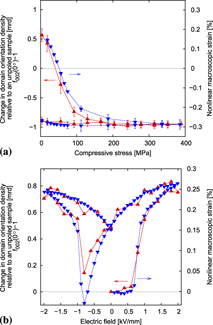Crossref Citations
This article has been cited by the following publications. This list is generated based on data provided by
Crossref.
Deng, Qihuang
Fan, Yuchi
Wang, Lianjun
Xiong, Zhi
Wang, Hongzhi
Li, Yaogang
Zhang, Qinghong
Kawasaki, Akira
and
Jiang, Wan
2012.
Effects of Polarization on Mechanical Properties of Lead Zirconate Titanate Ceramics Evaluated by Modified Small Punch Tests.
Japanese Journal of Applied Physics,
Vol. 51,
Issue. 1R,
p.
011501.
Ochoa, Diego A.
García, Jose E.
Tamayo, Idalberto
Gomis, Vicenç
Damjanovic, Dragan
Perez, Rafel
and
Roedel, J.
2012.
Effect of Uniaxial Compressive Stress on Dielectric and Piezoelectric Responses in Lead Zirconate Titanate Based Ceramics.
Journal of the American Ceramic Society,
Vol. 95,
Issue. 5,
p.
1656.
Ochoa, Diego A.
Pérez, Rafel
and
García, Jose E.
2013.
Preisach modelling of nonlinear response in electrically biased lead zirconate titanate-based piezoceramics.
Applied Physics A,
Vol. 112,
Issue. 4,
p.
1081.
Tutuncu, Goknur
Li, Binzhi
Bowman, Keith
and
Jones, Jacob L.
2014.
Domain wall motion and electromechanical strain in lead-free piezoelectrics: Insight from the model system (1 − x)Ba(Zr0.2Ti0.8)O3–x(Ba0.7Ca0.3)TiO3 using in situ high-energy X-ray diffraction during application of electric fields.
Journal of Applied Physics,
Vol. 115,
Issue. 14,
Esteves, Giovanni
Fancher, Chris M.
and
Jones, Jacob L.
2015.
In situ characterization of polycrystalline ferroelectrics using x-ray and neutron diffraction.
Journal of Materials Research,
Vol. 30,
Issue. 3,
p.
340.
Esteves, Giovanni
Fancher, Chris M.
Wallace, Margeaux
Johnson-Wilke, Raegan
Wilke, Rudeger H.T.
Trolier-McKinstry, Susan
Polcawich, Ronald G.
and
Jones, Jacob L.
2016.
In situ X-ray diffraction of lead zirconate titanate piezoMEMS cantilever during actuation.
Materials & Design,
Vol. 111,
Issue. ,
p.
429.
Khatua, Dipak Kumar
K. V., Lalitha
Fancher, Chris M.
Jones, Jacob L.
and
Ranjan, Rajeev
2016.
Coupled domain wall motion, lattice strain and phase transformation in morphotropic phase boundary composition of PbTiO3-BiScO3 piezoelectric ceramic.
Journal of Applied Physics,
Vol. 120,
Issue. 15,
Esteves, Giovanni
Fancher, Chris M.
Röhrig, Sören
Maier, Günther A.
Jones, Jacob L.
and
Deluca, Marco
2017.
Electric-field-induced structural changes in multilayer piezoelectric actuators during electrical and mechanical loading.
Acta Materialia,
Vol. 132,
Issue. ,
p.
96.
Adhikary, Gobinda Das
and
Ranjan, Rajeev
2020.
Abrupt change in domain switching behavior within tetragonal phase regime of (x)Na1/2Bi1/2TiO3-(1 − x)K1/2Bi1/2TiO3.
Journal of Applied Physics,
Vol. 128,
Issue. 20,
